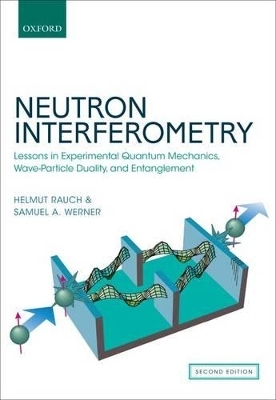
Neutron Interferometry
Oxford University Press (Verlag)
978-0-19-871251-0 (ISBN)
This is an open access title. It is available to read and download as a free PDF version on Oxford Academic and is made available under a Creative Commons Attribution-Non Commercial-No Derivatives 4.0 International licence.
The quantum interference of de Broglie matter waves is probably one of the most startling and fundamental aspects of quantum mechanics. It continues to tax our imaginations and leads us to new experimental windows on nature. Quantum interference phenomena are vividly displayed in the wide assembly of neutron interferometry experiments, which have been carried out since the first demonstration of a perfect silicon crystal interferometer in 1974. Since the neutron experiences all four fundamental forces of nature (strong, weak, electromagnetic, and gravitational), interferometry with neutrons provides a fertile testing ground for theory and precision measurements. Many Gedanken experiments of quantum mechanics have become real due to neutron interferometry.
Quantum mechanics is a part of physics where experiment and theory are inseparably intertwined. This general theme permeates the second edition of this book. It discusses more than 40 neutron interferometry experiments along with their theoretical motivations and explanations. The basic ideas and results of interference experiments related to coherence and decoherence of matter waves and certain post-selection variations, gravitationally induced quantum phase shifts, Berry`s geometrical phases, spinor symmetry and spin superposition, and Bell's inequalities are all discussed and explained in this book. Both the scalar and vector Aharonov-Bohm topological interference effects and the neutron version of the Sagnac effect are presented in a self-contained and pedagogical way. Interferometry with perfect crystals, artificial lattices, and spin-echo systems are also topics of this book. It includes the theoretical underpinning as well as connections to other areas of experimental physics, such as quantum optics, nuclear physics, gravitation, and atom interferometry. The observed phase shifts due to the Earth's gravity and rotation indicate a close connection to relativity theory. Neutron interferometry can be considered as a central technique of quantum optics with massive particles. It has stimulated the development of interferometry with atoms, molecules and clusters.
The book is written in a style that will be suitable at the senior undergraduate and beginning of graduate level. It will interest and excite many students and researchers in neutron, nuclear, quantum, gravitational, optical, and atomic physics. Lecturers teaching courses in modern physics and quantum mechanics will find a number of interesting and historic experiments they may want to include in their lectures.
Helmut Rauch completed his PhD in 1965 and become full Professor in 1972. He spent one sabbatical year at KFA Juelich/Germany and worked regularly at the Institute Laue-Langevin in Grenoble/France. His scientific interests are: neutron physics, quantum optics, foundations of quantum mechanics, and reactor physics. He invented together with U. Bonse and W. Treimer the perfect crystal neutron interferometer, and has published more than 350 papers in refereed journals. He was Director of the Atomic Institute in Vienna, President of the Austrian Science Foundation and twice President of the Austrian Physical Society. He is member of the Austrian and German Physical Society, the Austrian Academy of Sciences, and the German Academy of Sciences "Leopoldina" in Halle. Honours include the Erwin Schrödinger Award of the Austrian Academy of Sciences, and the Ludwig Wittgenstein Award of the Austrian Research Association. Samuel Werner received his AB degree at Dartmouth College in 1959 and his PhD degree at the University of Michigan in 1965. He was a staff scientist in the Physics Department of the Scientific Laboratory of the Ford Motor Company for 10 years. He became Professor of Physics at the University of Missouri in 1975. Upon his retirement from Missouri in 2000 he moved to Gaithersburg, MD to become a guest researcher at NIST. His scientific interests are: neutron scattering, neutron physics, spin density waves (CDW) and charge density waves (SDW) in solids. He received the President's Award for Outstanding Research at the University of Missouri in 1980, the Outstanding Alumnus Award of the Nuclear Engineering Department at the University of Michigan in 1980, and an Exceptional Service Award of the Neutron Scattering Society of America in 2012. He was the first President of the NSSA. He is a Fellow of the NSSA, the American Physical Society, and the American Association for the Advancement of Science.
1. Introduction ; 2. Neutron interferometers and apparatus ; 3. Neutron interactions and the coherent scattering lengths ; 4. Coherence and decoherence ; 5. Spinor symmetry and spin superposition ; 6. Topological and geometric phases ; 7. Contexuality and Kochen-Specker phenomena ; 8. Gravitational, inertial and motional effects ; 9. Solid state physics applications ; 10. Forthcoming, proposed and more speculative experiments ; 11. Perfect crystal neutron optics ; 12. Interpretational questions and conclusions
| Zusatzinfo | 215 b/w illustrations |
|---|---|
| Verlagsort | Oxford |
| Sprache | englisch |
| Maße | 177 x 247 mm |
| Gewicht | 1000 g |
| Themenwelt | Naturwissenschaften ► Physik / Astronomie ► Atom- / Kern- / Molekularphysik |
| Naturwissenschaften ► Physik / Astronomie ► Quantenphysik | |
| ISBN-10 | 0-19-871251-0 / 0198712510 |
| ISBN-13 | 978-0-19-871251-0 / 9780198712510 |
| Zustand | Neuware |
| Haben Sie eine Frage zum Produkt? |
aus dem Bereich


